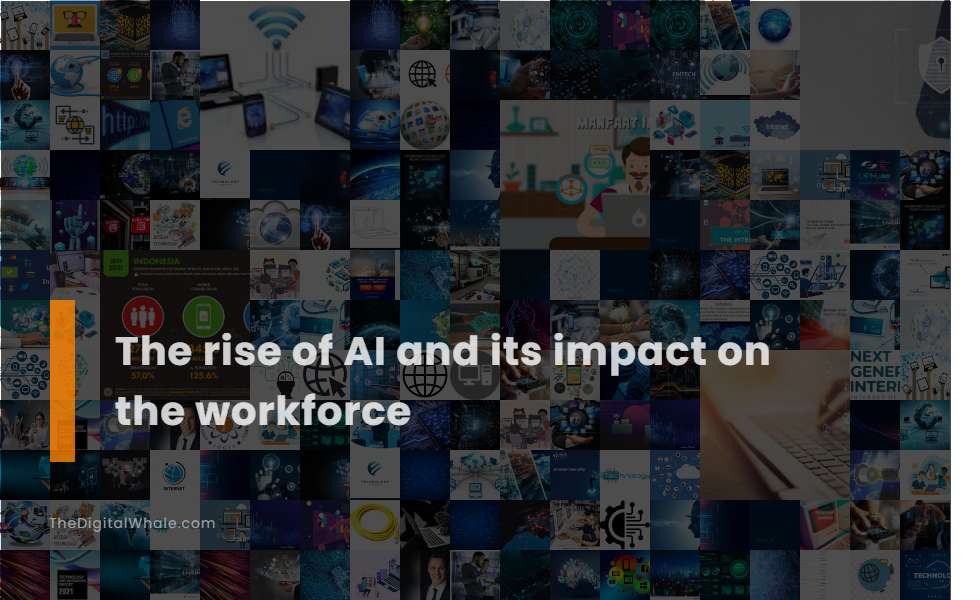The Rise of Ai and Its Impact On the Workforce
What are the potential implications of artificial intelligence (AI) in the workforce? What are the effects of AI on the workforce? Let's find out more about The Rise of Ai and Its Impact On the Workforce.

Automation of Routine Tasks
AI-powered automation significantly impacts the workforce by automating routine and repetitive tasks, freeing employees to focus on higher-value work such as strategic initiatives, creative problem-solving, and innovation, while also enhancing productivity, efficiency, and work-life balance. It automates repetitive, detail-oriented tasks, such as data processing and customer service, allowing employees to concentrate on more complex and strategic roles, thereby increasing efficiency, productivity, and safety in various industries. Additionally, [AI and Automation](https://www.xcubelabs.com/blog/how-ai-and-automation-can-empower-your-workforce/) empower the workforce by handling repetitive tasks, enabling employees to focus on higher-level thinking, creative problem-solving, and strategic initiatives, thus streamlining operations and unlocking the true potential of human capital.
Job Displacement and Creation
Artificial Intelligence's impact on the job market is multifaceted and transformative. While there is a significant concern about job displacement, especially in industries like manufacturing, retail, and logistics, AI simultaneously creates opportunities for new, high-demand roles. By 2025, it is estimated that although 85 million jobs may be displaced, 97 million new ones will emerge, especially in sectors such as healthcare, technology, and finance. This transformative change underscores the importance of reskilling workers to align with the evolving job landscape. The potential for AI to automate a considerable portion of tasks further underscores this need, with predictions that by 2030, generative AI could automate 29.5% of the hours worked in the U.S. economy. Importantly, an insightful exploration of this subject can be found on the St. Thomas Newsroom, which highlights how AI's integration not only requires the development of new skills but redefines the framework of the workforce. Therefore, while AI presents risks, it also offers a potent avenue for innovation and new employment opportunities.
Skill Shifts and Training Needs
The rise of AI is driving a significant shift in skill requirements, with a focus on upskilling and reskilling workers to adapt to automated tasks. Emphasizing skills such as high-level cognitive abilities, refined social and emotional skills, and technological proficiency is essential to prepare for more complex and creative work roles. As discussed on the Generative AI article, this transformation highlights the need to adapt and evolve workforce capabilities to meet the changing demands of the digital age.
Enhanced Productivity
Generative AI holds the potential to significantly boost the productivity of highly skilled workers by nearly 40% when utilized within its capabilities, specifically in areas like product development, marketing, and content creation. However, using it beyond these boundaries can result in a noticeable productivity drop. As discussed in the MIT Sloan article, the strategic application of Generative AI could be transformative, leading to labor productivity growth projected between 0.1 to 0.6 percent annually through 2040. This technology promises substantial benefits by streamlining tasks such as code generation, refactoring, and enhancing knowledge work through the rapid digestion and analysis of extensive data sets.
Changes in Industry Dynamics
The transformative power of AI is reshaping industry dynamics by automating routine tasks and creating new job opportunities, particularly in data analytics and AI development. This shift is fostering the emergence of a more educated and specialized workforce, with a strong emphasis on STEM fields. While AI automation leads to job displacement in sectors like manufacturing and retail, it simultaneously opens up roles in healthcare, pharmaceuticals, and other industries, necessitating that workers acquire new skills to stay relevant. AI-powered automation also replaces mundane tasks while evolving current job roles and generating technology-focused job positions, thus enhancing productivity and efficiency. As businesses strive for a competitive edge, AI encourages strategic thinking and the adaptation of workforces through talent acquisition and development strategies, ultimately pushing for innovation and allowing workers to concentrate on high-value tasks that require creativity and critical thinking.
Related:
What is the benefits of G network technology? What is G and what will it mean for the telecom industry? Let's find out more about What Is 5G and What Will It Mean for the Future?.
Ethical and Bias Concerns
The rise of AI in the workforce raises significant ethical and bias concerns, including the potential for job displacement, increased inequality, and the risk of AI systems being biased or unfair. Particularly in hiring and decision-making processes, these systems can perpetuate prejudices and invade personal privacy. For a deeper dive into these critical issues, visit the comprehensive analysis on AI's Impact on the Workforce to understand how these challenges are being addressed.
Remote Work and Virtual Teams
Artificial Intelligence (AI) is revolutionizing the way remote work operates by automating repetitive tasks, enhancing collaboration, and improving communication through advanced video conferencing, real-time translation, and smart scheduling. This transformation is significantly boosting productivity and enabling seamless team collaboration across distances. As AI continues to shape the future of work, it is imperative for remote workers to focus on reskilling, particularly in management and AI-specific skills, to adapt to the evolving job landscape. Generative AI is poised to automate digital tasks, offering the potential for increased productivity while redefining work processes through AI-driven communication platforms, virtual assistants, and smart project management systems, ultimately enhancing virtual collaboration and team efficiency.
Data-Driven Decision Making
The integration of AI in workforce analytics enables organizations to make data-driven decisions by processing vast amounts of data, identifying patterns, and generating predictive models. This enhances HR efficiency, predicts future workforce requirements, and improves employee engagement and satisfaction through personalized and targeted initiatives. To delve deeper into this advancement, Rippleworx offers insights into leveraging AI for smarter HR decisions, highlighting its transformative impact on organizational effectiveness.
AI-Augmented Roles
AI is ushering in the age of the augmented workforce, where human-machine partnerships boost productivity and deliver exponential business value, with AI automating routine tasks and freeing humans to focus on creative and high-value tasks. The use of AI empowers an augmented workforce by automating repetitive tasks, streamlining recruitment, and identifying skills gaps, which enhances overall productivity and employee satisfaction. By transforming the way businesses operate, IBM's Thought Leadership Institute on Business Value illustrates the significant potential of AI in allowing employees to concentrate on tasks requiring a human touch, contributing significantly to the modern workplace dynamics.
Regulatory and Policy Challenges
The rise of AI in the workforce presents considerable regulatory and policy challenges, including concerns over market competition, data privacy, intellectual property protection, national security, algorithmic bias, and financial stability risks. Regulations differ significantly between countries, underscoring the necessity for clear and consistent rules to tackle these challenges and mitigate potential labor displacement and discrimination. Meanwhile, the increasing use of AI in the workplace is shaping a new legal landscape in the United States. Government oversight and proposed regulations are being developed to address issues such as algorithmic discrimination, bias audits, and the implementation of internal governance programs to manage AI-related risks. For more insights on these developments, you can visit the New Legal Landscape Facing US Employers, highlighting the evolving challenges and approaches in different jurisdictions.
Related:
What is virtual reality? What are the different types of virtual reality? What is virtual reality, and how can it be used in the workplace? Let's find out more about Virtual Reality - What It Is and How It Can Be Used.
